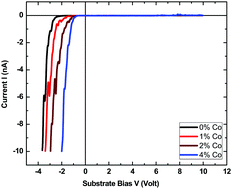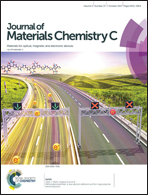Single quantum dot rectifying diode with tunable threshold voltage†
Abstract
An ambient atmosphere single quantum dot (QDs) rectifying diode with tunable threshold voltage has been fabricated using cobalt (Co) doped CdS QDs with a device structure of ITO/ZnO/QDs. Current–voltage (I–V) characterization of this device has been tested using ambient atmosphere scanning tunnelling microscope (STM). The scanning tunnelling spectra (STS) shows a very high rectification behavior of this single dot based device with a ratio of 103. The threshold voltage of this device decreases with increase in doping concentration of QDs. Reduction of this turn-on voltage occurs due to the formation of additional energy band of Co impurity within the band gap of QDs that exist closer to the valance band (VB) of CdS. Existence of this additional energy band has also been observed in the UV-VIS absorption data of Co doped CdS, which introduces an additional absorption peak in the near infrared region. This impurity band is fully populated at room temperature and the width of this band increases with doping concentration, which is the key for the tunability of threshold voltage. This finding has been explained with one empirical model of relative band shifting of semiconductor–QDs–tip interfaces with positive and negative substrate bias.



 Please wait while we load your content...
Please wait while we load your content...